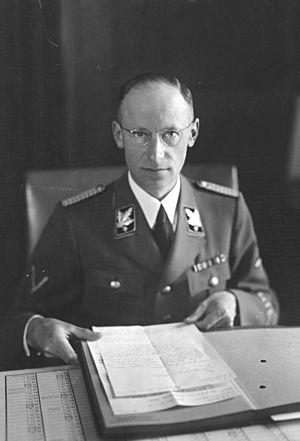Herbert Backe facts for kids
Quick facts for kids
Herbert Backe
|
|
|---|---|

Herbert Backe in 1942
|
|
| Minister Reich Ministry of Food and Agriculture |
|
| In office 6 April 1944 – 23 May 1945 (Acting from 23 May 1942) |
|
| Chancellor | Adolf Hitler |
| Preceded by | Richard Walther Darré |
| Succeeded by | Position abolished |
| State Secretary Reich Ministry of Food and Agriculture |
|
| In office 27 October 1933 – 6 April 1944 |
|
| Chancellor | Adolf Hitler |
| Preceded by | Hans Joachim von Rohr |
| Succeeded by | Hans-Joachim Riecke |
| Personal details | |
| Born |
Herbert Friedrich Wilhelm Backe
1 May 1896 Batumi, Kutais Governorate, Russian Empire |
| Died | 6 April 1947 (aged 50) Nuremberg Prison, Bavaria, Allied-occupied Germany |
| Cause of death | ... by hanging |
| Nationality | German |
| Political party | Nazi Party |
| Alma mater | University of Göttingen |
| Profession | Agronomist |
Herbert Friedrich Wilhelm Backe (born May 1, 1896 – died April 6, 1947) was a German politician during the time of Nazi Germany. He was also a high-ranking member of the SS. Backe served as a State Secretary and later as a Minister in the Reich Ministry of Food and Agriculture.
He was known for his strong beliefs in racial ideas. Backe was a close helper of Richard Walther Darré and a friend of Reinhard Heydrich. He helped create and put into action a plan called the Operation Hunger. This plan aimed to cause widespread starvation among millions of Slavic and Jewish people. This happened after the 1941 invasion of the Soviet Union, known as Operation Barbarossa.
Operation Hunger was planned before the invasion began. It involved taking food from Ukraine and sending it to the German army and people in Germany. This plan led to millions of local civilians dying from starvation in the German-occupied areas.
Contents
Herbert Backe's Early Life
Herbert Backe was born in Batumi, which is in Georgia. His father was a former Prussian soldier who became a trader. His mother was a Caucasus German. Her family had moved from Württemberg to Russia in the early 1800s.
He went to school in Tbilisi starting in 1905. When World War I began, he was held as an enemy because he was a citizen of Prussia. Being imprisoned and seeing the start of the Russian Revolution made Backe strongly against communism.
Moving to Germany and Studies
During the Russian Civil War, Backe moved to Germany. He got help from the Swedish Red Cross. At first, he worked as a laborer. In 1920, he began studying Agronomy at the University of Göttingen. Agronomy is the science of soil management and crop production.
After finishing his degree, he worked briefly in farming. Then, he became a teaching assistant for agricultural geography at Hanover Technical University. In 1926, he wrote a paper for his doctorate degree. This paper was about the Russian grain economy. It was seen as a plan for German occupiers to control food from local people.
Joining the Nazi Party and Rise to Power
Backe joined the SA in 1922. In 1925, he became a member of the Nazi Party in Hanover. Later, he let his membership end for a short time.
In 1927, Backe worked as an inspector and manager on a large farm in Pomerania. He married Ursula in 1928. With money from his father-in-law, he became a tenant of a farm called Hornsen in November 1928. This farm was about 950 acres. He managed the farm very well.
After the Nazis took power, Backe became the State Secretary in the Reich Ministry of Food and Agriculture. This happened on October 27, 1933. In the same month, he joined the SS. Backe also became a member of the Prussian State Council. In October 1936, he was chosen to represent agriculture for Hermann Göring's Four Year Plan.
When the Minister of Food and Agriculture, Richard Walther Darré, took a long break in May 1942, Backe took over his duties. Backe was also put in charge of Darré's role as the Reich Farmers Leader for the Nazi Party. On November 9, 1942, Backe was promoted to a high rank in the SS. Finally, on April 6, 1944, Hitler officially named Backe the Minister of the Reich Ministry of Food and Agriculture.
The Hunger Plan
Alfred Rosenberg, who was the Nazi Minister for the Occupied Eastern Territories, chose Backe for an important role. Backe became the Secretary of State for the Reichskommissariat Ukraine. This position allowed him to put his extreme and racist ideas into action. One of these was the Hunger Plan (also known as Der Backe-Plan).
The main goal of this plan was to cause widespread starvation among the Slavic people living under German control. It aimed to send all food supplies to the German people and the German Armed forces fighting on the Eastern Front. A key person who helped Herbert Backe with this plan was Hans-Joachim Riecke. He led the agriculture part of the Economic Staff East.
According to historian Timothy Snyder, Backe's plan had terrible results. Between 1941 and 1944, about 4.2 million Soviet citizens died from starvation. Most of these people were Russians, Belarusians, and Ukrainians.
See also
 In Spanish: Herbert Backe para niños
In Spanish: Herbert Backe para niños

